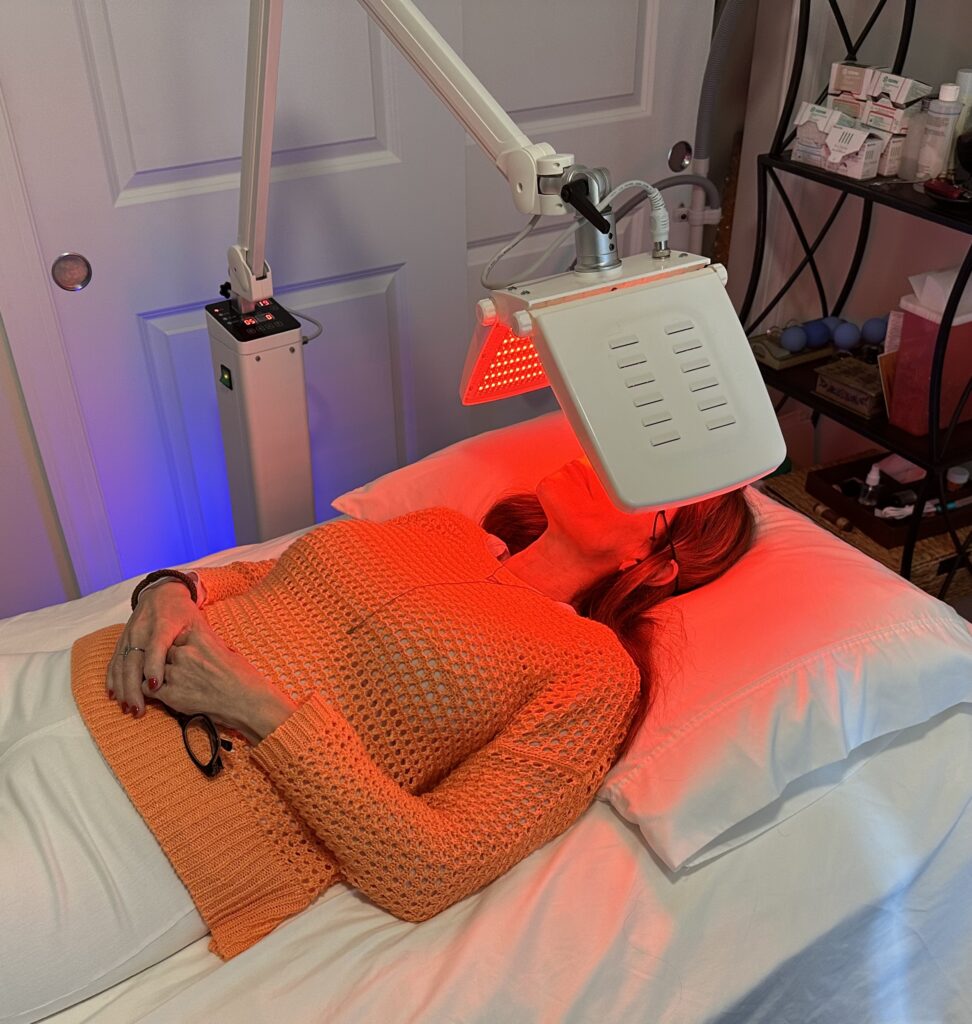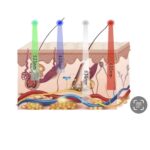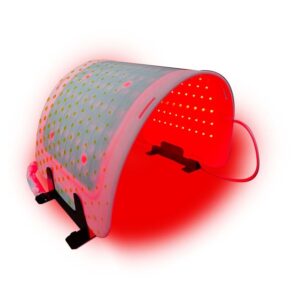From “Treating the Face: a Comprehensive Guide for Acupuncturists and Health Professionals Michelle Gellis AP

Light-emitting diode (LED) therapy, once a futuristic concept developed through NASA’s exploration of space-based healing, has now become a foundational treatment in clinical, cosmetic, and wellness settings. Initially studied to aid plant growth and accelerate wound healing in astronauts, LED therapy has evolved into a noninvasive, highly versatile modality that treats a wide range of concerns—from skin issues and hair loss to pain relief and general vitality.
LED therapy works by utilizing specific wavelengths of light to stimulate cellular activity. These wavelengths penetrate the skin at different depths, targeting inflammation, collagen depletion, pigmentation, and acne, among other concerns. Unlike laser or intense pulsed light (IPL) treatments that rely on heat-induced damage, LED is a nonablative therapy that promotes healing without harming the tissue. Various colors—red, blue, green, and yellow—are commonly used, each offering distinct benefits. Red light (620–700 nm) penetrates deeply to boost collagen production and reduce signs of aging. Blue light (415–450 nm) works on the surface, effectively treating acne by targeting Propionibacterium acnes. Green light (532nm) calms irritated skin and helps reduce hyperpigmentation, while Yellow Light (590 nm) Enhances cellular oxygen exchange and improves microcirculation.
NASA’s research in the 1990s revealed red light’s ability to stimulate tissue regeneration, leading to FDA approval in 2002 for uses ranging from anti-aging and acne to hair loss and pain management. This therapeutic effect occurs through a process known as photobiomodulation, where light interacts with mitochondria in the cells to stimulate ATP (adenosine triphosphate) production, powering the repair and regeneration of tissues.
Several parameters are essential for optimizing LED therapy. Wavelength, measured in nanometers (nm), determines how deeply the light penetrates the skin and which tissues it targets. Irradiance (mW/cm²) refers to how much energy is delivered per second, while joules per square centimeter (J/cm²) measure the total dose of energy over time. Lumen (lm), which measures visible brightness, does not reflect therapeutic efficacy. Effective doses range from 3–6 J/cm² for skin rejuvenation and 20–50 J/cm² for deeper tissue issues and pain relief.
The benefits of LED and red light therapy
The benefits of LED and red light therapy extend far beyond surface concerns. For skin rejuvenation and anti-aging, red light increases collagen and elastin synthesis, enhances circulation, reduces inflammation, and improves skin texture. It boosts cellular turnover, softens fine lines and wrinkles, reduces pigmentation, and minimizes pore size for a smoother, more youthful complexion. For hair regrowth, red light stimulates ATP production within the hair follicles, supports the anagen (growth) phase, enhances circulation, reduces scalp inflammation, and activates stem cells to improve hair density and follicle strength.
Pain relief and muscle recovery are also significant applications. Red and near-infrared light (700–1000 nm) penetrate deep into muscle and connective tissues, reducing inflammation and enhancing mitochondrial function. This makes it a valuable tool for addressing arthritis, neuropathic pain, and post-exercise muscle soreness. In wound healing, red light therapy promotes collagen production, tissue repair, and angiogenesis while modulating inflammatory cytokines, which reduces swelling and encourages nerve regeneration. It is especially helpful for healing injuries, scars, and burns.
Red light therapy can also reduce the appearance of cellulite by improving circulation, stimulating collagen production, and supporting lymphatic drainage. It may even help release fatty acids from fat cells, leading to smoother skin. Additionally, red light exposure in the evening may improve sleep quality by promoting melatonin production, without suppressing it like blue or green light can. This supports the body’s circadian rhythms, leading to deeper, more restorative rest.
Recent research suggests red and near-infrared light may support mitochondrial health by activating DNA repair enzymes, reducing oxidative stress, and encouraging autophagy—the cellular cleansing process linked to longevity and immune resilience.
LED therapy is widely used for a variety of skin conditions including eczema, acne, rosacea, psoriasis, wrinkles, sagging skin, actinic keratosis, hyperpigmentation, and sun damage. For hair loss, red light can be integrated into cosmetic acupuncture treatments or used alongside microneedling to boost scalp health and improve follicle function. Red light therapy also supports lymphatic and circulatory function by promoting vasodilation and lymph drainage, enhancing detoxification, reducing edema, and increasing overall energy and vitality.
Treatment protocols
Treatment protocols vary depending on the application. For skin treatments, sessions typically last 10–20 minutes and can be performed 3 to 7 times per week, with maintenance requiring 2 to 3 sessions weekly. Hair loss treatments often involve 30-minute sessions at the same frequency. For deep tissue therapy, 15 to 20 minutes of exposure at about six inches from the skin is recommended.
Choosing the right device is essential for both safety and effectiveness. Devices range from small tabletop units and flexible pads to large floor-standing models. Important considerations include the wavelength range (630–660 nm is ideal for superficial skin treatments), power output (to ensure therapeutic dosage), coverage area, and light intensity. Built-in safety features such as eye protection, automatic timers, and temperature controls are also important.
Despite its many advantages, there are precautions to observe. LED therapy should not be used on individuals who are pregnant or breastfeeding (especially over the breasts or abdomen), taking photosensitizing medications, under 12 years old, or diagnosed with seizure disorders or active cancer. Eye protection is essential during all sessions, and devices should never be used near water or open heat sources.
LED therapy offers practitioners a high-value, low-effort addition to their clinical repertoire. It can be used as a stand-alone modality or integrated into cosmetic acupuncture, microneedling, or general wellness programs. Providers may offer packages, rent devices, or conduct staff-led sessions, with minimal training and maximum client satisfaction. As both a therapeutic and marketing tool, LED and red light therapy deliver visible, measurable results that align with the growing demand for noninvasive, science-backed health and beauty treatments.


